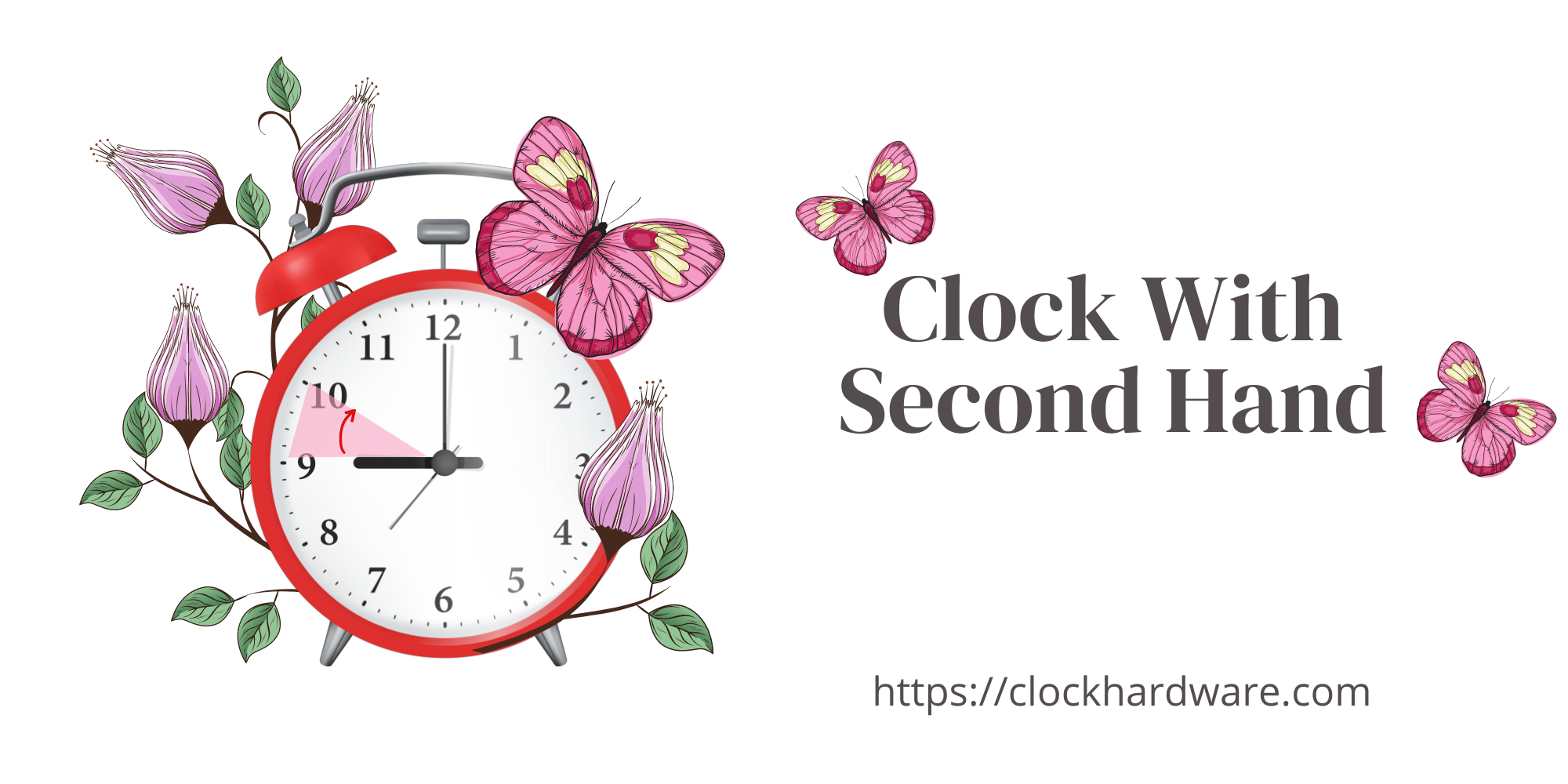Clocks are an integral part of our daily lives, helping us keep track of time and stay organized. While digital clocks have become increasingly popular, there is something uniquely captivating about a clock with a second hand. In this article, we will explore the emotional significance and practical benefits of clocks with second hands, diving into their evolution, applications, and the nostalgic connection they hold.
Clocks with second hands are timekeeping devices that provide a more precise measurement of time by dividing each minute into smaller increments. These clocks consist of an hour hand, a minute hand, and a second hand, each moving at different speeds to indicate the passage of time.
In our fast-paced world, where every second counts, clocks with second hands play a vital role in keeping us on track and helping us manage our time effectively.
The Evolution of Timekeeping
Humanity’s quest to measure time accurately dates back thousands of years. From ancient sundials to water clocks and mechanical timepieces, timekeeping devices have evolved significantly. However, it wasn’t until the introduction of the clock with a second hand that time measurement reached new levels of precision.
The first clock with a second hand is credited to the Dutch mathematician and astronomer Christiaan Huygens in the late 17th century. This invention revolutionized timekeeping and laid the foundation for modern clocks with second hands.
The Significance of the Second Hand
The second hand plays a crucial role in enhancing the accuracy of timekeeping. By dividing each minute into 60 seconds, it allows for more precise measurements. This precision is particularly important in fields such as scientific research, athletics, and even everyday activities like cooking.
Moreover, the second hand enables us to measure time intervals with greater accuracy. Whether timing an event or gauging the duration of a task, the second hand provides a valuable tool for accurate time management.
Precision and Synchronization
Precision is vital when it comes to timekeeping. Clocks with second hands are meticulously designed and calibrated to ensure accurate timekeeping. Manufacturers employ various techniques, including high-quality movements and precise gear mechanisms, to achieve optimal precision.
Additionally, clocks with second hands can be synchronized with external time references, such as atomic clocks, ensuring consistency and accuracy across different timekeeping devices. This synchronization is particularly important in fields where precise timing is crucial, such as scientific experiments or coordinating large-scale events.
Applications of Clocks with Second Hands
Clocks with second hands find applications in various domains, including:
- Time management and productivity: The visual representation of time passing on a clock with a second hand aids in managing tasks and deadlines effectively.
- Scientific research and experimentation: Scientists rely on precise time measurements to conduct experiments, monitor reactions, and collect accurate data.
- Sports and athletics: From race timing to training sessions, clocks with second hands are essential for athletes to monitor their performance and improve their results.
- Astronomical observations: Astronomers often use clocks with second hands to track celestial events, planetary movements, and astronomical phenomena.
The Emotional Connection to Clocks with Second Hands
Clocks with second hands hold a special place in our hearts, evoking emotions and nostalgic memories. Here are some reasons why:
- Nostalgia and sentimental value: Analog clocks with second hands remind us of a simpler time, bringing back memories of childhood, family gatherings, and cherished moments.
- The rhythmic movement of the second hand: The smooth and continuous motion of the second hand can have a calming effect, creating a sense of rhythm and order in our daily lives.
- Symbolism and metaphorical associations: The ticking of the second hand can symbolize the passage of time, urging us to make the most of every moment and appreciate the present.
The Impact of Digital Clocks
Digital clocks with second displays have gained popularity due to their convenience and ease of reading. However, their rise has impacted the prevalence of clocks with second hands. Let’s explore the advantages and disadvantages of digital clocks:
- Advantages:
- Precise and accurate time display
- Additional features like alarms and timers
- Easy readability, especially for people with visual impairments
- Disadvantages:
- Lack of the tactile experience and visual charm of analog clocks
- Inability to perceive the passing of time as easily
- Dependence on batteries or external power sources
Maintaining and Caring for Clocks with Second Hands
To ensure optimal performance and longevity of clocks with second hands, proper maintenance is essential. Here are some tips for caring for these timekeeping treasures:
- Cleaning and maintenance tips: Regularly dust and clean the clock using a soft cloth. Avoid using abrasive materials or harsh chemicals that may damage the finish.
- Importance of regular servicing: Schedule periodic servicing by a professional to keep the clock in excellent working condition. This includes lubrication, adjustment, and any necessary repairs.
- Common issues and troubleshooting: Familiarize yourself with common issues such as inaccurate timekeeping, sticking second hand, or chimes not functioning correctly. Consult a professional if needed.
Conclusion
Clocks with second hands hold a significant place in our lives, combining practicality with emotional value. They serve as a reminder of the fleeting nature of time, urging us to make every moment count. Whether in scientific labs, sports arenas, or our homes, clocks with second hands continue to play an essential role in our daily routines and evoke a range of emotions.
Incorporate Clocks with Second Hands into Your Life: Make Every Second Count!
Now is the time to embrace the beauty and functionality of clocks with second hands. Enhance your time management, cultivate a sense of rhythm, and cherish the emotional connection to this timeless symbol of precision and nostalgia.
FAQs
1. How accurate are clocks with second hands? Clocks with second hands can achieve varying levels of accuracy depending on their quality and movement. Higher-end timepieces are often designed to be highly accurate, with minimal deviations over time.
2. Can I replace the second hand if it breaks? Yes, in most cases, a broken or damaged second hand can be replaced. It’s recommended to consult a professional watchmaker or clock repair specialist for assistance.
3. Are there any famous clocks with second hands? Yes, several famous clocks with second hands have gained recognition worldwide. Examples include Big Ben in London, the Prague Astronomical Clock, and the Clock Tower of the Palace of Westminster.
4. Can I convert a digital clock into one with a second hand? Converting a digital clock into an analog one with a second hand may not be possible in most cases, as it would require significant modifications to the clock’s internal mechanisms. It’s generally more practical to purchase a dedicated clock with a second hand.
5. Why are analog clocks with second hands still popular? Analog clocks with second hands continue to be popular due to their timeless appeal, emotional connection, and the unique experience they offer. Many people appreciate the aesthetics and nostalgic value that analog clocks bring to their surroundings.

Meet Aron Crock, a clock hardware expert with seven years of hands-on experience. Aron’s journey into the world of clocks began as a hobby, but his passion soon turned into a profession. He’s known for his deep understanding of clock mechanisms and is highly respected in the field. Aron’s dedication to making clocks tick with precision and his innovative ideas have made him a key player in the industry. He’s committed to pushing the boundaries of clock technology and leaving a lasting impact on the world of timekeeping. Aron Crock is a true clock enthusiast, and his expertise shines through in his work.

